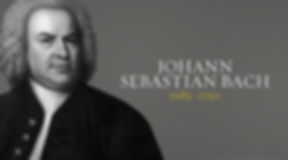

Established 2007
SOLI DEO GLORIA
Welcome!
Strengthened by the Spirit: from Despair to Hope
May 18, 2025, 7:30pm
First Presbyterian Church, Lexington, KY
The cantata Erschallet ihr Lieder, BWV 172 was written by Bach for Whit Sunday, the first day of Pentecost. It is filled with references to the Holy Spirit and features a duet aria between the solo soprano (soul) and the solo alto (Holy Spirit) in the fifth movement. The motet Der Geist hilft, BWV 226 has repeated references to the Holy Spirit, and also to the Pentecostal fire (“Du heilige Brunst, süsser Trost”). It ends hopefully with a reference to eternal life (“Durch Tod und Leben zu dir dringen. Halleluja.”). The second half of the program, following the intermission, consists of a group of pieces that move from sadness, fear, longing, and despair to the hope of resolution, salvation, and joy. It begins with Die mit Tränen säen, a setting of selected verses from Psalm 126 by Bach’s predecessor, Heinrich Schütz, referring to those who sow with tears and then return joyfully bearing their sheaves. Following are two pieces by Felix Mendelssohn. The first, Hear my prayer (Hör mein Bitten), is the petition of one currently experiencing sadness and fear to find lasting hope and peace; these two contrasting states are depicted beautifully in the music. Verleih’ uns Frieden is a more fervent prayer for peace. Josef Rheinberger’s Abendlied is a plea to God to remain with us during the approaching darkness of the evening, to remain with us until the ensuing light. Likewise, Paulus’ Pilgrim’s Hymn is a tender prayer to God to praise him for staying with us on the path from “darkness sealing us in” to light. Ending the program is a reassuring, jubilant chorus from Mendelssohn’s oratorio Elijah with the exhortation “Be not afraid” to those experiencing dire times because “thy [God’s] help is near.”
Steve Bolster

PROGRAM
Strengthened by the Spirit: from Despair to Hope
Stephen C. Bolster, Guest Conductor
May 18, 2025
May 18, 2025, 7:30pm
First Presbyterian Church, Lexington, Kentucky
I
Erschallet, ihr Lieder, erklinget ihr Saiten, BWV 172 (19 min). Johann Sebastian Bach
Choir, Soloists, and Orchestra
II
Der Geist hilft unser Schwachheit auf, BWV 226 (8‘32“). Johann Sebastian Bach
Choir and Orchestra
~Intermission~
III
Die mit Tränen säen (Geist. Chormusik, 1648), SWV 378 (4‘10“). Heinrich Schütz
Choir and Organ, Continuo
IV
Hear my prayer (Hör mein Bitten) (11 min). Felix Mendelssohn
Verleih‘ uns Frieden (4‘44“). Felix Mendelssohn
Choir and Organ
V
Abendlied, Op. 69, No. 3 (5’16). Josef Rheinberger
Choir, unaccompanied
VI
Pilgrim’s Hymn (3’51“). Stephen Paulus
Choir, unaccompanied
VII
Be Not Afraid! (from Elijah) (4 min). Felix Mendelssohn
Choir and Organ
P R O G R A M
Light Eternal, Light Perpetual
Sunday, March 2, 2025
First Presbyterian Church, Lexington, KY 7:30 p.m.
Dr. Vicki Bell, Guest Conductor
Part One
(about 37 minutes of music, including audience participation in Bach chorale)
O Lamm Gottes, unschuldig (BWV 618)
J. S. Bach (1685-1750)
Dr. Zachary Klobnak, organ
Ubi caritas et amor, Deus ibi est
Paul Mealor (b. 1975)
Ich lasse dich nicht (BWV 1164)
J. S. Bach
Audience participation: sing a Bach Chorale!
Herr Jesu Christ, wahr’ Mensch und Gott (BWV 127)
J. S. Bach
-
Choral: Herr Jesu Christ, wahr’r Mensch und Gott
-
Recitative: Wenn Alles sich zur letzten Zeit entsetzet
-
Aria: Die Seele ruht in Jesu Händen
-
Recitative & Aria: Wenn einstens die l’o saunen schallen
-
Chorale: Ach Herr, vergieb all’ unsre Schuld
INTERVAL (10-15 minutes)
Part Two
(about 35 minutes of music)
Ave verum corpus
William Byrd (c. 1539-1623)
Stabat Mater
G. P. da Palestrina (1525-1594)
Requiem in D minor, op. 48
Gabriel Fauré (1845-1924)
V. Agnus Dei
VI. Libera me
VII. In paradisum
Selig sind die Toten, die in dem Hereen sterben
Heinrich Schütz (1585-1672)
P R O G R A M
Sunday, December 8, 2024, 3 PM
Dr. Kirk Rich, guest conductor, finalist
"Ding! Dong! Merrily on high!"
traditional, arranged by Mack Wilberg (b. 1955)
Ave Maria
Franz Biebl (1906-2001)
Dylon Crain, tenor and Matthew Houston, baritone
"The Magi's Dream"
James Whitbourn (1963-2024)
"Komm, Jesu, komm", BWV 229
Johann Sebastian Bach (1685-1750)
"What sweeter music"
John Rutter (b. 1945)
Missa Brevis (2009)
Jonthan Dove (b. 1959)
II. Gloria
Two settings of "O Magnum Mysterium"
Tomas Luis de Victoria (ca 1548-1611)
Morten Lauridsen (b. 1943)
I N T E R V A L
Wachet auf, ruft uns die Stimme, BWV 140
J. S. Bach
I. Chorus
II. Recitative-Dylon Crain, tenor
III. Duet, Troy Sleeman, baritone; Kelli Evans, soprano
IV. Chorus
V. Recitative-Troy Sleeman
VI. Duet-Troy Sleeman; Whitney Perrine, soprano
VII. Chorus